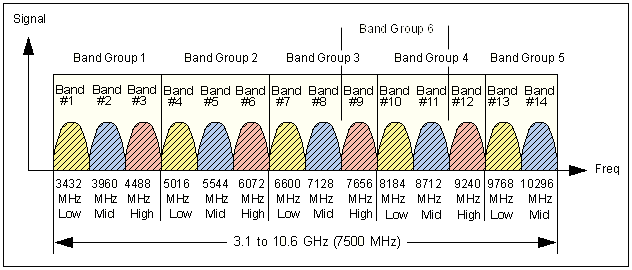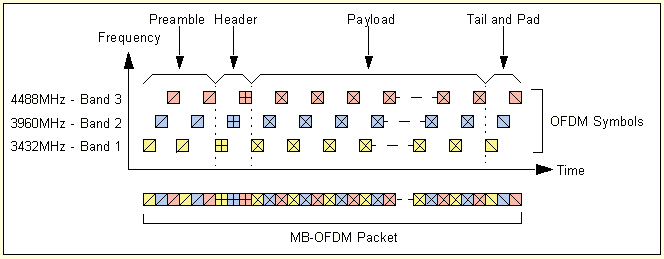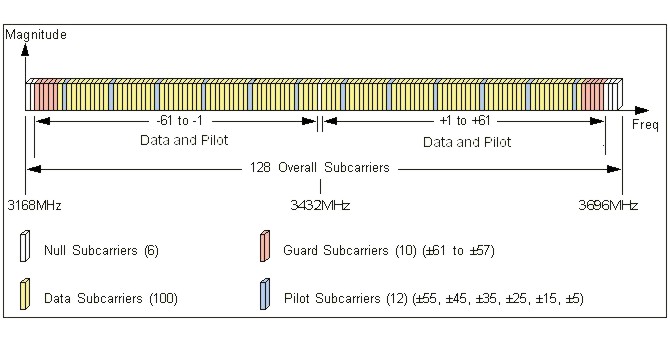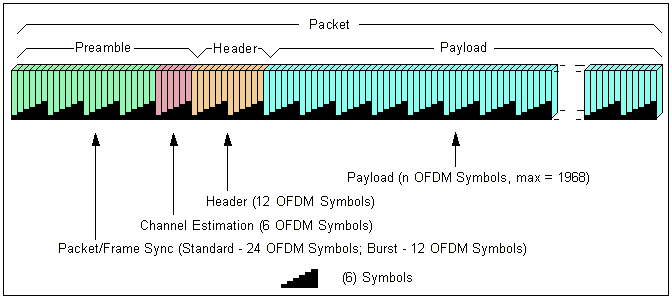MB-OFDM Modulation Overview (MB-OFDM)
This topic describes a Multiband-Orthogonal Frequency Division Multiplex (MB-OFDM Orthogonal Frequency Division Multiplexing: OFDM employs multiple overlapping radio frequency carriers, each operating at a carefully chosen frequency that is Orthogonal to the others, to produce a transmission scheme that supports higher bit rates due to parallel channel operation. OFDM is an alternative tranmission scheme to DSSS and FHSS.) implementation of Ultra-Wideband (UWB) technologies.
- MB-OFDM Band Groups and Bands
- MB-OFDM Frequency Hopping
- MB-OFDM Time-Frequency Codes
- MB-OFDM Band Group and Band Frequencies
- OFDM Symbols
- OFDM Symbol Baseband
- OFDM Symbol-Times
- MB-OFDM Packet
- MB-OFDM Data Rate Parameters
MB-OFDM Band Groups and Bands
This MB-OFDM implementation of UWB divides the 7500 MHz Megahertz: A unit of frequency equal to one million hertz or cycles per second. spectrum bandwidth into (6) band groups and (14) non-overlapping bands spaced at 528 MHz bandwidth each, where each band provides a carrier frequency for an OFDM Symbol Baseband signal. To allow for such a large signal bandwidth, there are power restrictions which prevent MB-OFDM devices from disturbing narrower band devices nearby, such as 802.11ab/g radios. Typically, MB-OFDM devices operate within a 10 meter radius.

Band Group and Band Frequencies
The table below summarizes the Band frequencies within each Band Group.
|
Band Group and Band Frequencies |
||||
|---|---|---|---|---|
|
Band Group |
Band |
Lower Frequency (MHz) |
Center Frequency (MHz) |
Upper Frequency (MHz) |
|
1 |
1 |
3168 |
3432 |
3696 |
|
2 |
3696 |
3960 |
4224 |
|
|
3 |
4224 |
4488 |
4752 |
|
|
2 |
4 |
4752 |
5016 |
5280 |
|
5 |
5280 |
5544 |
5808 |
|
|
6 |
5808 |
6072 |
6336 |
|
|
3 |
7 |
6336 |
6600 |
6864 |
|
8 |
6864 |
7128 |
7392 |
|
|
9 |
7392 |
7656 |
7920 |
|
|
4 |
10 |
7920 |
8184 |
8448 |
|
11 |
8448 |
8712 |
8976 |
|
|
12 |
8976 |
9240 |
9504 |
|
|
5 |
13 |
9504 |
9768 |
10032 |
|
14 |
10032 |
10296 |
10560 |
|
|
6 |
9 |
7392 |
7656 |
7920 |
|
10 |
7920 |
8184 |
8448 |
|
|
11 |
8448 |
8712 |
8976 |
|
|
Color codes: |
Low |
Mid |
High |
|
MB-OFDM Frequency Hopping
In operation, MB-OFDM “hops” between portions of the MB-OFDM spectrum and concatenates the individual OFDM symbol bursts into a single MB-OFDM packet (see below). A hopping sequence always consists of six hops between Bands but within a single Band Group. For example, Band Group 1, and hops of Bands 1-2-3-1-2-3.

Time-Frequency Codes (TFC)
The parameter that determines the hopping sequence of the six OFDM symbol bursts is the Time-Frequency Code (TFC Transport Format Combination). For example, the hopping sequence for TFC 1 in Band Group 1 is Band 1-2-3-1-2-3. Band Groups 2 - 4 and Band Group 6 follow the same sequences using their respective bands. For example, the sequence for TFC 1 in Band Group 2 is Band 4-5-6-4-5-6 and Band Group 6 is Band 9-10-11-9-10-11. Band Group 5 only hops between two bands and thus has it's own sequence.
There are three TFC catagories:
- TFI or Time-Frequency Interleaved uses TFCs 1 - 4 (hop sequence between 3 bands)
- FFI or Fixed-Frequency Interleaved uses TFCs 5 - 7 (hop sequence stays within 1 band or non-hopping))
- TFI2 or two-band Time-Frequency Interleaved uses TFCs 8 - 10 (hop sequence between 2 bands)
The Table below displays the six-hop sequence for each TFC in Band Group 1 and the TFCs in Band Group 5. The bands are color coded to show the three TFC categories (TFI, FFI, and TFI2). Band Groups 1 - 4 and Band Group 6 each supports (4) TFI codes, (3) FFI codes, and (3) TFI2 codes. Band Group 5 supports (2) FFI codes and (1) TFI2 code. Traces represent Bands as Low, Mid, and High (see note in table below).
|
Time-Frequency Codes (TFC) |
||||||||
|---|---|---|---|---|---|---|---|---|
|
TFC |
Band |
Base |
Band Hopping Sequence |
|||||
|
1 |
1 |
1 |
1 |
2 |
3 |
1 |
2 |
3 |
|
2 |
2 |
1 |
3 |
2 |
1 |
3 |
2 |
|
|
3 |
3 |
1 |
1 |
2 |
2 |
3 |
3 |
|
|
4 |
4 |
1 |
1 |
3 |
3 |
2 |
2 |
|
|
5 |
5 |
1 |
1 |
1 |
1 |
1 |
1 |
|
|
6 |
6 |
2 |
2 |
2 |
2 |
2 |
2 |
|
|
7 |
7 |
3 |
3 |
3 |
3 |
3 |
3 |
|
|
8 |
8 |
1 |
2 |
1 |
2 |
1 |
2 |
|
|
9 |
9 |
1 |
3 |
1 |
3 |
1 |
3 |
|
|
10 |
10 |
2 |
3 |
2 |
3 |
2 |
3 |
|
|
|
||||||||
|
5 |
5 |
5* |
13 |
13 |
13 |
13 |
13 |
13 |
|
6 |
6* |
14 |
14 |
14 |
14 |
14 |
14 |
|
|
8 |
8* |
13 |
14 |
13 |
14 |
13 |
14 |
|
|
* Only 5, 6 and 8 are defined. |
||||||||
|
Color codes: |
Low |
|
Mid |
|
High |
|
||
OFDM Symbols
Each Band of 528 MHz bandwidth is divided into 128 orthogonal subcarriers spaced 4.125 MHz apart. There are six null subcarriers with two at the lower end, one in the middle, and three at the upper end, resulting in 128 - 6 = 122 useful subcarriers, numbered -61 to -1, and +1 to +61 (see illustration below).
An OFDM symbol-time is 1/4.125 MHz = 242.42 nSec. Additional processing adds a Null Cyclic Suffix time of duration 70.08 nSec, resulting in an overall OFDM symbol-time of 312.50 nSec (see below). The Null Cyclic Suffix mitigates the effects of multi-path at the receiving end, plus provides a time window to allow sufficient time for the transmitter and receiver to switch between the different Band center frequencies during hopping (burst) sequences.

OFDM Symbol Baseband
The multiplexed baseband signal provides 122 subcarriers: -61 to -1, and +1 to +61. Of these 122 subcarriers, (10) are Guards, (12) are Pilots, and the remaining (100) are Data. The center frequency (3432 MHz in this example) is null subcarrier 0, which is a characteristic of orthogonal signals. Note that in trace displays, guard subcarriers and pilot subcarriers are different colors than the data subcarriers.

OFDM Symbol-Times
MB-OFDM parameter entries on the Time tab, Packet tab, and Advanced tab are in units of symbol-time. As discussed above in OFDM Symbols, a symbol-time is 312.5 nSec in duration and consists of an OFDM Symbol (242.42 nSec) plus a Null Cyclic Suffix (70.08 nSec).
MB-OFDM Packet
An MB-OFDM packet consists of concatenated OFDM Symbols dedicated to Packet/Frame Sync, Channel Estimation, Header, and then Payload (see below). The combination of Packet/Frame Sync and Channel Estimation forms the Preamble. The preamble appears in two forms: the Standard Preamble consists of (24) Packet/Frame Sync symbol-times and (6) Channel Estimation symbol-times for a total of (30) symbol-times, while the Burst Preamble consists of (12) Packet/Frame Sync and (6) Channel Estimation symbol-times for a total of (18) symbol-times. The number of symbol-times in a packet is always divisible by 6 since the basic coding unit is 6 symbols. Packet length can be any length from a minimum of (42) OFDM Symbols (no Payload) to (2010) OFDM Symbols (full Payload) at the lowest data rate.
For Data Rates of 53.3, 80, 106.7, 160.0 and 200.0Mb/sec, all packets use the Standard Preamble; for Data Rates of 320.0, 400.0 and 480Mb/sec, the first packet uses the Standard Preamble, after which the remaining packets may use either the Standard Preamble -or- the Burst Preamble, in which case the preamble type is coded in the Header for the next packet. Typically, you use the Burst Preamble in a streaming mode, where a burst of packets is transmitted with only a minimum inter-frame separation time.

MB-OFDM Data Rate Parameters
The following table lists the eight Data Rate choices and shows the operating parameters for each choice.
Data Rate (Mb/sec)- Choose the Data Rate for your signal under test. The choices are: 53.3, 80.0, 106.7, 160.0, 200.0, 320.0, 400.0, and 480.0Mb/sec.
Modulation Types- Modulation types include Quadrature Phase Shift Keying (QPSK Quadrature phase shift keying), and Dual-Carrier Modulation (DCM), where DCM is effectively 16-Quadrature Amplitude Modulation at the bit level.
Coding Rate- Coding Rate indicates the ratio between an input bit stream and the resulting output bit stream, which is used for forward error correction. For example, a coding rate of 1/3 means an input bit stream produces three output bits for every input bit; or 5/8 where an input stream produces 8 output bits for every 5 inputs bits, and so forth.
FDS/TDS- Frequency-Domain Spreading (FDS) within an OFDM Symbol, and Time-Domain Spreading (TDS) across two consecutive OFDM Symbols is used to obtain further MB-OFDM bandwidth expansion. FDS entails transmitting the same information (complex number) on two separate subcarriers within the same OFDM Symbol; TDS involves transmitting the same information across two consecutive OFDM Symbols. Using this technique, frequency diversity is maximized and performance is improved in the presence of non-coordinated devices.
Coded Bits/Info Bits- Coded Bits/Info Bits refers to the overall coded bits from 6 OFDM Symbols and the overall information bits from 6 OFDM symbols.
Preamble - Shows the preamble type for each Data Rate; Standard or Burst.
|
MB-OFDM Data Rate Parameters |
|||||||
|---|---|---|---|---|---|---|---|
|
Data Rate (Mb/sec) |
Modulation Type |
Coding Rate |
FDS |
TDS |
Coded Bits* |
Info Bits* |
Preamble |
|
53.3 |
QPSK |
1/3 |
Yes |
Yes |
300 |
100 |
Standard |
|
80.0 |
QPSK |
1/2 |
Yes |
Yes |
300 |
150 |
Standard |
|
106.7 |
QPSK |
1/3 |
No |
Yes |
600 |
200 |
Standard |
|
160.0 |
QPSK |
1/2 |
No |
Yes |
600 |
300 |
Standard |
|
200.0 |
QPSK |
5/8 |
No |
Yes |
600 |
375 |
Standard |
|
320.0 |
DCM |
1/2 |
No |
No |
1200 |
600 |
Standard/ |
|
400.0 |
DCM |
5/8 |
No |
No |
1200 |
750 |
Standard/ |
|
480.0 |
DCM |
3/4 |
No |
No |
1200 |
900 |
Standard/ |
|
* Per (6) OFDM Symbols |
|||||||
See Also
Setting up a Measurement (MB-OFDM)
